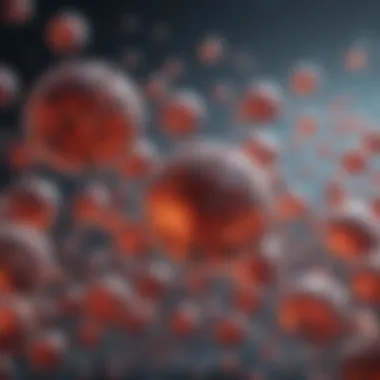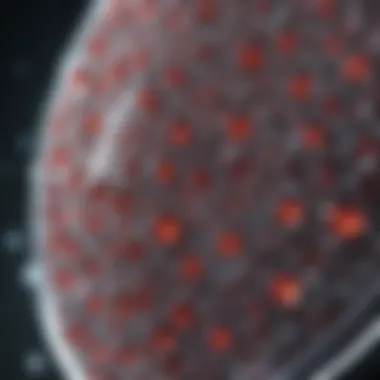Understanding Cell Line Contamination Issues


Intro
Cell line contamination poses a significant hurdle in biological research, undermining the reliability of experimental data. The repercussions of such contamination extend not only to individual studies but also to the broader scientific discourse. Understanding this phenomenon is crucial for researchers across various fields. Therefore, it is essential to explore the origins, consequences, and solutions related to cell line contamination.
Whether intentional or unintentional, contamination can drastically alter experimental outcomes, leading to erroneous conclusions. The integrity of cell lines must be maintained for consistent results and valid comparisons. Addressing this issue provides an opportunity for collective advancement in research standards and practices.
Methodology
Overview of research methods used
A thorough examination of cell line contamination involves a diverse range of research methods. Initially, a comprehensive literature review is essential. This includes scrutinizing peer-reviewed articles, covering a multitude of studies that have investigated cell line contamination. It also entails analyzing historical data regarding contamination incidents to highlight prevalent trends.
In addition, employing experimentation allows for the analysis of various contamination sources. Researchers often use both qualitative and quantitative approaches to gather data. Interviews with laboratory personnel can yield insights into common practices that may lead to contamination. Observational studies can also reveal the effectiveness of existing protocols.
Data collection techniques
Data collection encompasses several techniques tailored to understand contamination comprehensively. Among them, the following approaches are often utilized:
- Surveys: Distributing structured surveys to researchers working in laboratories can capture their experiences and awareness regarding contamination.
- Microscopy: Utilizing microscopy techniques to visually inspect cell cultures can help identify contamination types, such as bacterial or fungal.
- PCR testing: Polymerase chain reaction (PCR) assays are effective for detecting specific contaminants, providing a reliable method for ensuring cell line purity.
- Cell authentication: Techniques like short tandem repeat (STR) profiling may be employed to authenticate cell lines, ensuring they have not been misidentified or contaminated.
"Maintaining the integrity of cell lines is paramount to ensure the accuracy of scientific inquiry."
Future Directions
Upcoming trends in research
As the scientific community continues to evolve, trends in research focus heavily on improving contamination prevention strategies. Innovations in technology, including automated systems for monitoring cell cultures, can provide real-time alerts for contamination. Furthermore, integrating artificial intelligence into data analysis can help predict potential contamination events based on historical data.
Areas requiring further investigation
Despite strides in understanding cell line contamination, several areas remain under-researched. For instance, the specific environmental factors influencing contamination rates deserve attention. Exploring the impact of varying laboratory practices on contamination might lead to more effective control measures. Additionally, understanding the molecular mechanisms behind certain contaminants can inform better detection methods.
Prolusion to Cell Line Contamination
Cell line contamination is a critical issue that researchers in biological and medical fields must address. It affects the reliability and reproducibility of experimental results, which are fundamental to advancing scientific knowledge. When a cell line is contaminated, it can lead to erroneous conclusions, wasted resources, and a setback in research progress. The significance of understanding this phenomenon cannot be overstated in today's research landscape.
In this article, we will discuss the various aspects of cell line contamination, starting from its definition to historical context and implications on research outcomes. This examination is crucial for students, researchers, educators and professionals who are involved in cell-based studies.
Defining Cell Line Contamination
Cell line contamination refers to the unintentional introduction of foreign cells or microorganisms into a culture of established cell lines. This unwanted intrusion can occur due to factors such as improper handling, cross-contamination with other cultures, and microbial infections. Consequently, the integrity of the cell line is compromised, resulting in altered growth patterns, phenotypes, or even genetic make-up. The impact of this contamination extends beyond just the affected cell lines; it undermines the validity of research findings that rely on accurate cell behavior and characteristics.
This type of contamination comes in several forms, including cross-contamination where one cell line overtakes another in a culture, microbial contamination from bacteria or fungi, and misidentification of the cell line itself. Each of these forms presents its own challenges and consequences for scientific research.
Historical Overview
The issue of cell line contamination has been recognized for several decades. In the early days of cell culture, the prevalence of contamination was often underestimated, leading to significant repercussions for researchers. Studies in the 1970s and 1980s started shedding light on the problem, revealing that up to 15-30% of cell cultures could be contaminated. A notable incident in the 1960s involved the HeLa cell line, which spread rapidly and contaminated many other cell lines, highlighting the urgency of the issue.
In response to these findings, the scientific community began to develop better practices and guidelines for cell culture management. Over time, international organizations like the National Institutes of Health and the World Health Organization have implemented stricter protocols. These protocols aim to improve cell line authentication and minimize contamination risks in laboratories. Despite these efforts, the problem persists, reinforcing the need for ongoing education and comprehensive strategies to combat contamination in cell cultures.
Causes of Cell Line Contamination
Understanding the causes of cell line contamination is crucial for researchers and scientists working in laboratories. These contaminants can undermine the integrity of biological research, leading to invalid data and questionable results. Identifying the sources of contamination allows for better prevention strategies that ultimately enhance the credibility of scientific studies and drug development processes.
Cross-Contamination
Cross-contamination occurs when cells from one cell line mix with those from another. This can happen unintentionally during routine handling. For instance, using the same pipette tips or reagents without proper sterilization procedures can result in introducing foreign cells into a culture. Additionally, an inadequate cleanroom environment can facilitate the spread of contaminants.
The implications of cross-contamination are profound. If a cell line is contaminated, it can render research findings inaccurate. Experiments designed to assess specific biological processes may yield results that are actually influenced by the properties of a different cell line. This misapplication can inherently skew data interpretation and lead to erroneous conclusions.
Microbial Contamination


Microbial contamination refers to the presence of bacteria, fungi, or viruses in cell cultures. These organisms can proliferate rapidly, often going unnoticed until they have compromised the integrity of the culture. Common sources include contaminated culture media, improperly sterilized equipment, and even personnel handling the cultures without following proper hygiene protocols.
Detecting microbial contamination can be challenging, especially in its early stages. Indicators may include unexpected changes in pH or turbidity, which can signal urgent issues. If not addressed in a timely manner, microbial presence can inhibit cell growth or alter cellular behavior, further complicating research efforts.
Cell Line Misidentification
Cell line misidentification represents a major form of contamination, usually arising from the incorrect labeling or cataloging of cell lines. This situation can lead to the use of a cell line that has a completely different genetic background than intended. Sometimes, labs acquire cell lines without proper verification of their identity. The consequences can extend beyond individual research projects and may affect entire fields of study.
In particular, poorly identified cell lines can confuse the pharmaceutical industry, which relies on consistency and accuracy when testing drug efficacy. If new drugs are evaluated using contaminated or misidentified lines, results may misrepresent therapeutic potential or safety.
"Proper cell line identification is essential not only for experimental validity but also for maintaining public trust in scientific results."
By addressing these causes of contamination thoroughly, researchers can work towards minimizing their prevalence and ensure more reliable data, which is vital for the progress of science.
Impacts of Contamination on Research
Cell line contamination is a critical concern that can have severe consequences for research outcomes. Understanding its impacts on research helps to recognize the need for stringent measures for maintaining cell line integrity. Researchers must be cognizant of the underlying issues related to contamination, as these not only jeopardize individual studies but can also misinform broader scientific understanding.
Implications for Experimental Validity
Experimental validity hinges on the accuracy and reliability of results. Contaminated cell lines can lead to misinterpretation of experimental data. For instance, if a cell line is cross-contaminated, the obtained results may not reflect the true biological response under investigation. This can mislead researchers, skewing conclusions and fostering erroneous theories.
Factors affecting experimental validity include:
- Biological Variability: Differences in cellular behavior due to contamination can introduce variability, making it difficult to reproduce results.
- Result Interpretation: Contaminated data may lead researchers to draw incorrect conclusions, impacting further studies and publications.
- Resource Misallocation: Time and funding might be wasted on research that should not have been pursued.
Furthermore, the reputational damage associated with untrustworthy results can diminish public confidence in scientific research, influencing funding and collaboration opportunities.
Consequences for Drug Development
Cell lines are integral to drug development processes. The presence of contamination can lead to significant setbacks in pharmaceutical research. Contaminated cell lines can result in:
- Safety and Efficacy Issues: If cell lines do not accurately portray the target biological system due to contamination, drugs may fail in clinical trials, leading to health risks.
- Regulatory Implications: Regulatory agencies expect rigorous validation of cell lines used in drug development. Failure to meet these standards due to contamination can lead to approval delays or rejection.
- Increased Costs: The financial implications of failed trials due to contaminated cell lines are enormous. Companies may face substantial losses and delays in bringing products to market.
"Maintaining the integrity of cell lines is essential not only for the success of individual studies but also for the advancement of science as a whole."
Detection Methods for Contamination
Detection methods for contamination are crucial in the realm of cell line research. They serve as a foundational pillar for ensuring the validity and reliability of experimental results. Recognizing contamination early can mitigate adverse effects, protecting the integrity of both current and future research. By employing diverse detection strategies, researchers can not only identify contamination but also address it efficiently. This section discusses various methods used to detect cell line contamination, emphasizing their specific features and benefits.
Morphological Assessment
Morphological assessment is a technique that relies on the visualization of cell morphology to identify abnormalities indicative of contamination. This method typically utilizes microscopy to observe changes in cell shape, size, and growth patterns.
Abnormal cell morphology is often a key indicator of contamination, especially in mixed cultures where different cell types may interact.
While this approach is straightforward and does not require advanced technology, it is somewhat subjective and may vary between observers. Additionally, morphological changes can result from factors other than contamination, such as environmental stress or incorrect culture conditions. Nevertheless, it remains a useful first-line method for quick assessments.
Molecular Techniques
Molecular techniques are more precise methods for detecting cell line contamination. They include various advanced methodologies that analyze genetic material or proteins within the cells. Two prominent molecular techniques are DNA fingerprinting and STR analysis.
DNA Fingerprinting
DNA fingerprinting is a powerful molecular technique that utilizes variations in the genetic material of organisms. It identifies unique patterns in DNA sequences that can distinguish one cell line from another. The key characteristic of this method is its high specificity, allowing for precise identification of cell lines.
Researchers find DNA fingerprinting beneficial due to its capability to uncover misidentified or contaminated cell lines effectively. One unique feature is its applicability across various species, making it a versatile choice in cell line studies. However, DNA fingerprinting can be resource-intensive, requiring significant time and technical expertise, which might be a disadvantage in some settings.
STR Analysis
STR analysis, or Short Tandem Repeat analysis, is another prominent molecular technique used for cell line identification. It focuses on specific regions in the DNA where short sequences are repeated. This approach is characterized by its efficiency and speed, allowing for rapid assessments of cell line authenticity.


The primary benefit of STR analysis is its high resolution and capability to differentiate even closely related cell lines. Furthermore, it is relatively straightforward and can be conducted with commonly available laboratory equipment. However, like other molecular methods, STR analysis requires proper interpretation of the results to avoid misdiagnosis.
Microbial Testing
Microbial testing involves checking for the presence of unwanted microorganisms in cell cultures. This testing is vital as microbial contamination can compromise experimental outcomes significantly. Techniques such as culturing samples on specific media or employing molecular diagnostics help in detecting microbial presence.
This method serves as an essential counterpart to both morphological and molecular techniques. By ensuring cultures are free from microbial contaminants, researchers can uphold the integrity of their cell line work. However, the need for specialized equipment and procedures may restrict its application in some smaller labs.
In summary, the detection of contamination is a multifaceted process involving various techniques tailored to different aspects of cell line integrity. Each method has its own strengths and weaknesses, necessitating a comprehensive approach that integrates several detection strategies for effective contamination management.
Prevention Strategies
Preventing cell line contamination is crucial for maintaining the integrity of biological research. Effective strategies not only protect the quality of experimental data but also preserve the reputation of research institutions. By implementing robust prevention measures, researchers can minimize the risk of contamination and ensure reproducibility of results.
Good Laboratory Practices
Adhering to good laboratory practices (GLP) is essential in preventing cell line contamination. This involves establishing a sterile environment for cell cultures. Key aspects include:
- Regular cleaning and sterilization: Work surfaces and equipment must be routinely cleaned using appropriate disinfectants to eliminate microbial contaminants.
- Use of personal protective equipment (PPE): Lab coats, gloves, and masks should be mandatory to prevent unintentional transfer of contaminants from personnel to cell lines.
- Controlled access: Limiting entry to cell culture areas reduces the chances of contamination from external sources. Only authorized personnel should be allowed access.
By following these practices, laboratories can significantly reduce the likelihood of contamination incidents.
Regular Authentication Protocols
Regular authentication of cell lines is a critical component of contamination prevention. Incorrectly identified cell lines can produce misleading results. Researchers should employ various methods for regular authentication, such as:
- Short Tandem Repeat (STR) analysis: STR profiling is essential for confirming the identity of cell lines based on genetic markers.
- DNA sequencing: Sequencing ensures that the genetic makeup matches the expected profile for a particular cell line.
Implementing these protocols periodically minimizes risks associated with misidentification. It also fosters confidence among researchers and funding bodies about the authenticity of the results.
Education and Training
Education and training are fundamental in fostering a culture of contamination awareness among laboratory personnel. It’s important that everyone involved in handling cell lines understands the implications of contamination and the necessary prevention strategies. Effective training programs should include:
- Workshops on contamination sources: These should cover the various forms of contamination—cross-contamination and microbial exposure.
- Best practices demonstrations: Practical sessions teach staff how to handle cell lines properly, emphasizing sterile techniques.
- Management of symptomatic incidents: Training on how to report and respond to contamination incidents can help mitigate the impacts.
Ensuring ongoing education serves to reinforce the importance of vigilance in laboratory settings.
Regulatory Framework and Guidelines
The regulatory framework governing cell line contamination is crucial in maintaining the reliability of research outcomes. It sets the standards for best practices, providing a roadmap for laboratories to follow. Adhering to these guidelines not only ensures the integrity of the research but also promotes reproducibility across the scientific community. Institutions that implement strict regulations foster an environment of accountability, which minimizes the risks associated with contamination.
International Guidelines
International guidelines play a vital role in establishing universally accepted protocols for cell line management. Organizations such as the World Health Organization (WHO), the Food and Drug Administration (FDA), and the European Medicines Agency (EMA) have developed comprehensive recommendations aimed at reducing contamination risks.
The key areas covered by these guidelines include:
- Authentication of Cell Lines: Recommending methods such as DNA profiling to confirm the identity of cell lines.
- Laboratory Standards: Emphasizing the need for sterile techniques and maintenance of clean environments.
- Training Requirements: Mandating training for personnel to ensure they understand contamination risks and prevention strategies.
"International collaboration is essential for harmonizing the regulations relating to cell line management, fostering an environment in which research can thrive effectively and efficiently."
Institutional Policies
Every research institution must establish clear policies to manage cell line contamination effectively. These policies should reflect both international guidelines and tailored strategies to address the unique challenges faced by the institution.
Important considerations for institutional policies include:
- Regular Audits: Implementing periodic reviews of laboratory practices to identify areas needing improvement.
- Clear Reporting Structures: Encouraging transparency when contamination is detected, allowing for timely interventions.
- Collaboration with Regulatory Bodies: Ensuring alignment with national and international regulatory standards, which can help institutions stay updated on new guidelines.
By establishing robust policies and frameworks, institutions not only safeguard their own research integrity but also contribute to the overall advancement of the scientific field.


Regular updates and revisions of these policies ensure that they remain relevant amid evolving scientific understanding and technological advancements.
Future Trends in Cell Line Management
The landscape of cell line management is consistently evolving, reflecting advancements in technology and methodologies. As research becomes increasingly complex, the ability to effectively manage cell line integrity through novel approaches will become fundamental. Understanding these emerging trends is essential as contamination issues have profound ramifications on experimental reliability and reproducibility. Thus, keeping abreast of the latest developments ensures researchers can safeguard their findings and maintain the credibility of their work.
Advancements in Detection Technology
With growing concerns about cell line contamination, detection technologies have significantly evolved. Traditional methods such as morphological assessments remain vital, yet they often lack sensitivity for identifying subtle contamination types. Thus, researchers are integrating advanced techniques such as DNA fingerprinting and short tandem repeat (STR) analysis.
These molecular methods provide a more precise identification of cell lines, reducing the risk of misidentification and ensuring the purity of biological materials. High-throughput sequencing and polymerase chain reaction (PCR) techniques are also gaining traction, offering quick and robust detection of microbial presence.
Some key aspects include:
- Increased specificity: Newer methods enhance the accuracy of detecting contamination sources.
- Speed: Rapid testing promotes timely decisions in research workflows.
- Cost-effectiveness: Advances in technology tend to reduce costs over time as methods become more widely adopted.
"The implementation of molecular techniques marks a pivotal shift in how laboratories can assure cell line integrity, potentially reducing contamination incidences significantly."
Integration of AI and Data Analysis
Artificial Intelligence (AI) and data analysis are becoming indispensable tools in cell line management. The vast amount of data generated from experiments can be overwhelming. AI applications can assist in monitoring contamination risks by analyzing trends over time and predicting potential issues before they escalate.
This integration allows researchers to focus on more critical aspects of their work rather than manually scouring through datasets. Some advantages include:
- Predictive analytics: AI can forecast potential contamination events based on past data.
- Pattern recognition: It identifies unusual behavior in cultures which may indicate contamination.
- Automated reporting: Streamlines documentation processes, improving lab efficiency.
By employing these technologies, researchers can not only enhance their current protocols but also pave the way for innovative methodologies that will redefine cell line management in the future.
Case Studies of Contamination
Understanding cell line contamination is essential for researchers. By examining specific cases, it is possible to highlight the issues in research reproducibility and the real-world consequences of contamination. Such case studies not only unveil the mechanisms behind contamination but also showcase the responses and resolutions. These accounts provide lessons that help in developing better practices for the future. Learning from others ensures that similar mistakes can be avoided, ultimately leading to enhanced credibility in scientific results.
Notable Incidents in Research
One of the most infamous incidents of cell line contamination involved the HeLa cell line. Originally derived from Henrietta Lacks in the 1950s, HeLa cells were found to have contaminated various other cell lines in laboratories worldwide. This contamination led to significant disruptions in research, as many studies could not accurately correlate data to their intended cell lines. The implications were wide-reaching, from misleading findings to wasted resources in remediation efforts.
Another important example is the use of the C6 glioma cell line, which was eventually identified as a hybrid of human and rat cells. This misidentification had profound impacts on neurological research, as subsequent studies relying on these cells yielded results that were not biologically valid for human treatment.
These examples underscore the potential for cross-contamination and misidentification to skew scientific literature. The ramifications can stretch beyond individual studies, impacting the reliability of vast bodies of research. This highlights the need for strict adherence to authentication protocols.
Lessons Learned
Case studies provide valuable lessons that can inform future practice in cell line management. One key takeaway is the paramount importance of routine authentication. Techniques such as Short Tandem Repeat analysis and DNA fingerprinting should be standard practices in all laboratories working with cell lines.
Moreover, it is crucial for institutions to foster a culture of transparency. When contamination occurs, it should be documented and reported. This can lead to improved oversight and protocols in the long term. Additionally, investing in education and training in good laboratory practices can prevent contamination early on.
Lastly, these incidents emphasize the importance of a cautious and meticulous approach to cell line handling. Error or negligence in one phase of a research process can have cascading effects, ultimately weakening the entire research apparatus.
"The challenges of contamination distress the scientific community, but the lessons gained are invaluable for preventing future occurrences."
Closure
The exploration of cell line contamination is of utmost importance in the field of biological research. As highlighted throughout this article, the integrity of cell lines directly influences the validity of experimental outcomes. A thorough understanding of contamination sources, detection methods, and prevention strategies can empower researchers to preserve the reliability of their work.
Key Takeaways
- Contamination poses a serious threat to the validity of scientific research, leading to misleading results and wasted resources.
- Regular authentication of cell lines and training of personnel are key elements in preventing contamination.
- Technological advancements in detection, such as DNA fingerprinting and STR analysis, provide researchers with reliable tools to identify and mitigate contamination risks.
Call to Action for Researchers
Researchers must take proactive measures in addressing cell line contamination. Some recommendations include:
- Implementing standard operating procedures for cell line authentication and monitoring.
- Engaging in continuous education regarding contamination risks and advancements in detection.
- Collaborating with peers and institutions to share best practices in cell line management.
Taking these steps will not only enhance the reliability of individual research projects but will also contribute to the overall integrity of the scientific community.
"The reliability of experimental results hinges on the purity of cell lines. Only through diligence can we ensure the advancement of scientific knowledge."







